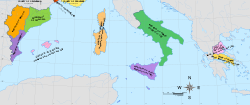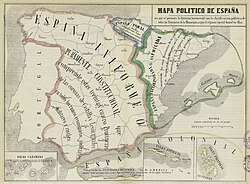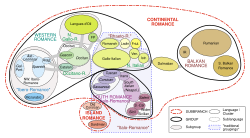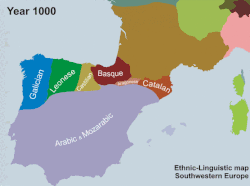Catalan language
The Catalan language is a Romance language spoken in Catalonia, Valencian Community, the eastern part of Aragon, the Balearic Islands, a small zone of Murcia (all of them in Spain), Andorra, North Catalonia (in France) and the Italian city of L'Alguer. Together, those places are often called the Catalan Countries.[4][5]
| Catalan/Valencian | ||||
|---|---|---|---|---|
| català/valencià | ||||
| Pronunciation | [kətəˈla]/[valensiˈa] | |||
| Native to | Spain, Andorra, France, Italy | |||
| Native speakers | 4.1 million[1] (2012) Total number of speakers: More than 10 million (L1 plus L2; 2018)[2] | |||
| Language family | ||||
| Early forms: | Old Catalan
| |||
| Standard forms | Catalan (regulated by the IEC)
| |||
| Writing system | Latin (Catalan alphabet) Catalan Braille | |||
| Official status | ||||
| Official language in | ||||
| Recognised minority language in | ||||
| Regulated by | Institut d'Estudis Catalans Acadèmia Valenciana de la Llengua | |||
| Language codes | ||||
| ISO 639-1 | ca | |||
| ISO 639-2 | cat | |||
| ISO 639-3 | cat | |||
| Linguasphere | 51-AAA-e | |||
 Territories where Catalan is spoken and is official Territories where Catalan is spoken but is not official Territories where Catalan is not historically spoken but is official | ||||
| ||||
The language that most similar is Occitan. Catalan also has similarities to other Romance languages, such as Spanish, Italian, French and Portuguese. It came from Vulgar Latin and was first spoken in the in the Eastern Pyrenees in the Middle Ages.[6][7]
There are about 4 million people who speak Catalan as a first language and about 6 million people as a second language. Catalan is the sixth-most-spoken Romance language and also the most-spoken language that is not an official language in the European Union.
Catalan Language Media
Diachronic map of the Crown of Aragon. King James the Conqueror (1208–1276) dictated his autobiographical chronicles entirely in Catalan. Some of this territory nowadays makes up the Catalan Countries
Political map of Spain (1850), divided into four parts: The Fully constitutional Spain (brown), most of the former Crown of Castile; Assimilated Spain (green), the former Crown of Aragon, including the Catalan-speaking lands; Foral Spain (blue), the Basque-speaking territories; and Colonial Spain (yellow)
A speaker of Catalan (Majorcan dialect)
Artur Mas, former president of Catalonia, discussing individual identity, collective identity and language
References
- ↑ "Catalan". Ethnologue. Retrieved 14 November 2017.
- ↑ "InformeCAT 50 dades sobre la llengua catalana" (PDF) (in Catalan). 7 June 2018.
{{cite web}}: CS1 maint: unrecognized language (link) Report on the Catalan language by Plataforma per la Llengua based on recent reference sociolinguistic surveys - ↑ 3.0 3.1 Some Iberian scholars may alternatively classify Catalan as Iberian Romance/East Iberian.
- ↑ Minder, Raphael (21 November 2016). "Italy's Last Bastion of Catalan Language Struggles to Keep It Alive". The New York Times. https://www.nytimes.com/2016/11/21/world/europe/catalan-italy-alghero.html. Retrieved 21 January 2017.
- ↑ Wheeler 2010, p. 191.
- ↑ Wheeler 2010, p. 190–191.
- ↑ Costa Carreras & Yates 2009, pp. 6–7.
- ↑ Carbonell & Llisterri 1999, p. 62.
- ↑ Feldhausen 2010, p. 6.
- ↑ Wheeler 2005, p. 2.
- ↑ Costa Carreras & Yates 2009, p. 4.
| This language has its own Wikipedia project. See the Catalan language edition. |








